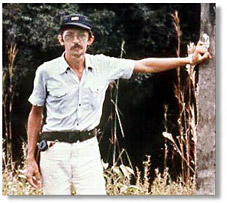

 |
 |
| Brazil
has about 3.000 over 26.000 species of orchids in the world; the state of
Minas Gerais can still be proud of the privilege of sheltering many of them.
However, they are more and more threatened of extinction by the factors
that befall in their environment, due the expansion of the population and
consequently intensive and non-sustained utilization of the natural resources,
and by the predatory collecting that reaches those with greater commercial
values. As a great part of the orchids lives on trees and palm trees, thus called "epiphyte", the destruction of the native vegetation (woods, woodlands savannah, rupestrian fields) also eliminates them. The employment of our areas to the pasture, agriculture and the supplying of the charcoal for the metallurgies of iron and steel has been reducing implacably the native vegetal covering; Minas Gerais, only to give a bad example, has, nowadays, just approximately 1,5% of the original forests, one of the worst rates of Brazil. |
| The open-cast mining, with scarification of the surface of the soil, eliminates mainly the rupestrian orchids (that vegetate on the rocks). Particularly in the ferriferous four-side (*) of the state of Minas Gerais, where there are rare and exclusive species in the world, extinction of varieties of orchids has already occurred. | 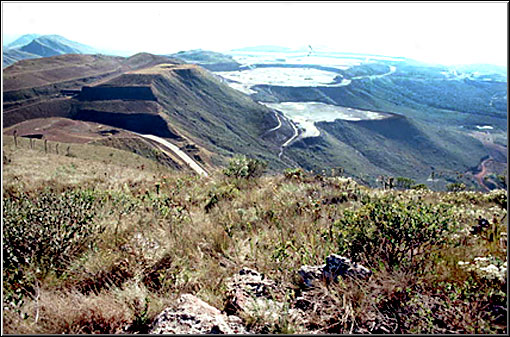 |
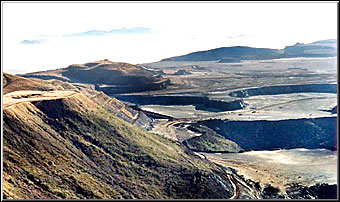 |
This used to be the habit of Laelia milleri. |
|
The mining operation of
gold and diamond has also been contributing to eliminate the orchids from the river banks, since more than two centuries. |
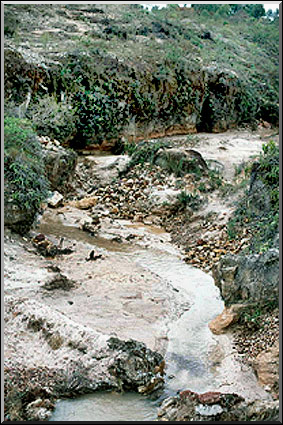 |
|
destroy the orchids growing on the soil as well those on the trees. National plague, the fires provoked to set up farming and cattle raisings are still an important agent of the flora and fauna's destruction, in the same way, the criminal fires in parks and ecological reserves are usual. 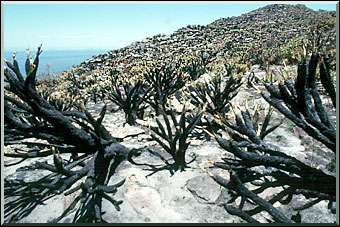 FIRE IN RUPESTRIAN FIELD Vellozia where there were L. liliputiana Pabst and Sophronitis brevipedunculata (Cogn.) Fow. |
|
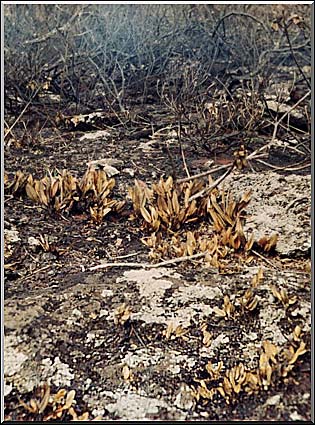 Laelias burnt in the canga (**) |
The dams built for hydroelectric power flooded the gallery woods, where the orchids are, exactly, more concentrated, due to the environmental humidity. Minas Gerais has a great number of hydroelectric powers and a big flooded area, an adequate work of rescuing species during the filling up of the dam has never been done.  Unscrupulous merchants from several states and also from abroad, selectively collect many plants - obviously those with greater commercial values - even in ecological parks, and thus they have already provoked the extinction of some species and varieties. Unfortunately the control is absolutely inefficient. The conscientious collecting done by collectors of some rarer specimens is, however, sometimes useful for the preservation because allowing the artificial reproduction that avoids, in this way, the disappearance of some varieties. It is up to the enthusiasts of this botanical family, organized into associations through the country, make to be written in their by-laws and statutes, clear and conditional determinations in the preservation field, that should be kept by every one involved in the subject, and should give to the population, in general, the knowledge and participation in actions such as: By periodical courses of initiation to orchids cultivation and advanced courses and lectures, make the population know the ways of being successful with the plants, besides to make people be conscious about the protection of the habitats. The instruction how to obtain cultivated plants, by change or acquisition from legal resources, discourage the indiscriminate collecting and the sale of native plants by unscrupulous merchants. The artificial reproduction is a matter to professional growers, however with the information of the procedures, more and more people take this task, the most efficient way of avoiding the extinction of orchids as it makes available selected, healthy, superior quality plants and rare in the nature, avoiding the collectings, in general, expensive and fruitless. A good example comes from the state of Rio Grande do Sul, where plants that were in the way of extinction, such as Laelia purpurata - Brazilian national flower - are nowadays protected because they have been so extensively artificially reproduced that made possible to cheaply buy varieties, before rare. It is an incipient activity to re-introduce species of extinct orchids in certain habits in to order to be naturally reproduced, mainly in parks and protected areas. There is a work in course together with the mining industries to maintain protected areas in the mines, to where the plants can be transferred from the areas which will be degraded and, much better, to re-establish exploited areas with native vegetation, included orchids. The cuttings are obtained by seeds cultivation and the species should always originally occur in the region. Consists in saving orchids in areas that will be destroyed, as occurring in the construction of roads, mines and flood areas of dams, in order to keep them under artificial cultivation or to transfer to safe areas. Unfortunately that, what should be a good way to help preservation is not very accomplished in practice because the responsible managers of the societies that harm the environment have the habit of hiding the true dimensions of the disaster they provoke. Orchid shows delight people and, there, we can attract who is interested in the cultivation and preservation of those admired plants. This is an opportunity to awake, mainly in the children, the ecological conscience. |
In our excursions along the diamonds region of the Espinhaço Mountain, precisely, in the district of Diamantina, we can notice the tenuous but promising reaction of the nature. As we know, the basin of Jequitinhonha and Velhas rivers have been ransacking all long the three centuries and some parts were razed by the alluvial mining of diamonds and gold and, under wonderful mountains, the treasure of semi-precious stones is still the important resource of subsistence of the region. |
| Quartz crystal are extracted on a large scale, to industrial usage, and the hand-made searching for a subterraneous mine is a still a hope of a sudden opulence for many people, who look for special crystals to collectors and jewellery. Narrow tunnels are manually dug to reach the bulge where the stones are encrusted in the fine sand, easily removable. |
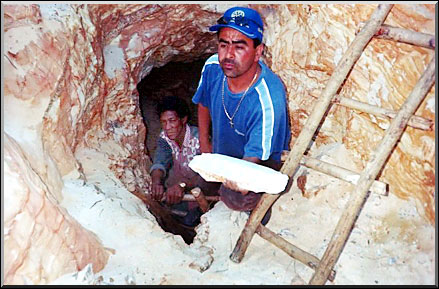 |
| Outside, in the surface, there are orchids over those metamorphic rocks, where the humus is accumulated - organic material, vegetal dejects, brought by the wind and the rains. In the manual procedure of alluvial mining, the prospectors let small heaps of refused small stones. Immense areas become covered with those small stones, next to small rivers and it has been being like this since the beginning of those activities. | 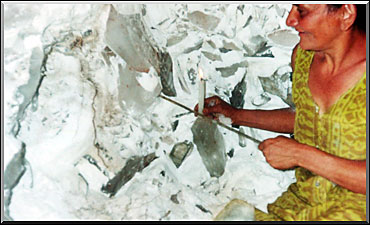 |
| There,
the pleasant surprise: an ideal environment for rupicolous orchids is, thus,
created with a layer of fine sand that allows the adequate drainage, small
stones that "hold" organic material and protect the roots from
direct sunstroke, keep some moisture and hinder the development of the concurrent
vegetation. We have already found in those degraded areas Pleurothallis teres Lindley, Cyrtopodium eugenii Rchb. f., Laelia rupestris Lindley, Laelia briegeri Blumenschein ex Pabst and Laelia bradei Pabst |
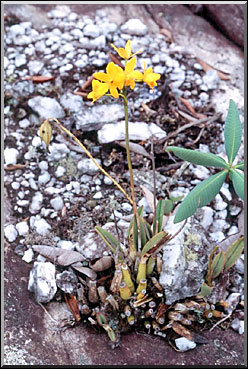 Laelia briegeri Blumenschein ex Pabst |
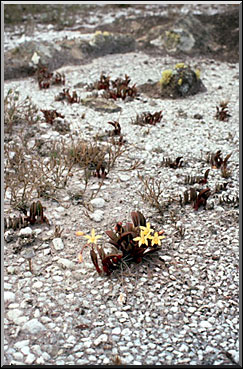 Laelia bradei Pabst |
| Accidentally, the old prospectors have constructed several containers fit for germination and development of many orchids that they themselves have contributed to decimate. The nature withstands and thanks with a shy but charming answer. |
| (*)Ferriferous
four-side is an old denomination gave to the central region of Minas
Gerais, due to the occurrences of iron ore which form, more or less, a four-side
polygon. There are many municipal districts, partial or integrally in this
area, we can mention: Belo Horizonte, Ouro Preto, Mariana, Catas Altas,
Santa Bárbara, Itabira, Rio Acima, Nova Lima, Itaúna, Moeda,
Itabirito, Conselheiro Lafaiete, Congonhas and Ouro Branco. The main mountains of this regions are: serra do Curral (in Belo Horizonte), do Caraça, de Capanema, de Moeda, de Itabirito, de Ouro Branco, do Itacolomi, de Ouro Preto, de Antônio Pereira. Espinhaço, Itacolomi and Mantiqueira are some complexes/super groups that include many parts of those mountains and of some others with different geological constitution. (**)
Canga is a residual united soil, which occurs over those ferriferous
formations. The rock that, normally, origins the "cangas" of Minas
Gerais is the itabirite, which is an ore formed by the iron oxide (which
mainly mineral is hematite - native red oxide of iron) and silica (quartz).
Guilherme Gravina, from Ouro Preto |